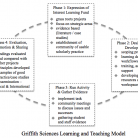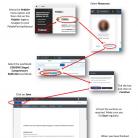
Griffith Sciences Blended Learning Model General Resource - Review and consider possibilities
Last updated on 30/10/2019
-
You must be signed in to access this function
3
Description
The Griffith Sciences Blended Learning Model is a professional learning framework designed to implement, in a sustainable way, the design principles of the Griffith Model using a new technology, PebblePad, adopted at Griffith University in 2017.
Overview

The Griffith Sciences Blended Learning Model is a professional learning model or framework designed to implement, in a sustainable way, the structural, pedagogical, and cultural design principles of the Griffith Model using a new technology, PebblePad, adopted at Griffith University in 2017.
Specifically, the model aimed to achieve the following:
- Investigate the potential uses or ‘affordances’ of blended learning (particularly those of personal learning environments/eportfolios) for STEM disciplines;
- Engage teachers from the Griffith Sciences in a professional learning framework to explore and invent pedagogies appropriate for blended learning in STEM;
- Implement the use of PebblePad in STEM disciplines;
- Develop a model for professional learning and adoption of technologies for Griffith Sciences; and
- Showcase this model and the individual contributions to other areas of the university, nationally and internationally.
Considerations
Steps:
- Expression of Interest – Blended Learning Fund. Dean of Learning and Teaching sent out an expression of interest to all academic staff to generate an idea or more utilizing PebblePad that could be funded. Funding was provided for program based initiatives, course based initiatives and initiatives to support staff using eportfolios for their own professional development.
- Completion of a Course Improvement template. To normalize and showcase PebblePad technology we used a template developed by us in PebblePad for successful academics to provide more details regarding their project (https://v3.pebblepad.com.au/spa/#/public/8kz7bb4z9mzqyqzyM7x4rhzMjW).
- Initial scoping meeting
- Finding out the details of the project
- Setting up a community of practice
- Showcase examples from previous blended learning fund participants (in later iterations)
- Discuss ethics application and research opportunities
- Develop a learning design
- Conversations with course convenors
- Modifications of learning design
- Discussions about how to make the eportfolio work
- Develop templates, resources, scaffolds, etc
- Support materials
- Personalised instructions for courses
- Standardised LMS page
- Training
- Course Convenor
- Teaching staff – creating an online study guide, helping students reflect
- Marking staff
- One on one support provided during the initiative
- Community meetings
- Discuss issues, ideas and practice
- Lunch meeting
- Provided 1 on 1 support wherever needed
- Evaluation
- Scholarly practice – developed an ethics application to cover specific STEM projects
- Ethics covered survey, focus group, SEC, access to PebblePad and LMS resources
- Community meeting – debrief
- Debrief
- Lessons learned
- Opportunities for showcasing and presentation
- Showcase / present findings
- Video case study / reflection
- Book chapter / journal article / conference presentation
- Presentation at University Forum – ePortfolio Symposium
- Presentation at external events
Implement
Faculty Sparks of projects implementing ePortfolios through the model:
- David Tuffley - 1st Year Bachelor of IT
- Gayle Brent - Griffith Sciences PLUS program
- Arie Korf - Flight procedures training
- Sarah Cresswell - Forensics - Using PebblePad to collect evidence of learning
- Leigh-Ellen Potter - Using PebblePad as a Design Brief
- Adam Palmer - Supporting Science students to be problem solvers
- Caryl Bosman - Building Urban & Environmental students' career paths
- Sebastian Binnewies & Zhe Wang - Promoting active learning and equity in a hyflex course
Contributed by
-
Griffith Sciences
Christopher Allan
christopher.allan@griffith.edu.au
-
Griffith Sciences
David Green
david.green@griffith.edu.au
Licence
© 2024 Griffith University.
The Griffith material on this web page is licensed under a Creative Commons Attribution NonCommercial International License (CC BY-NC 4.0). This licence does not extend to any underlying software, nor any non-Griffith images used under permission or commercial licence (as indicated). Materials linked to from this web page are subject to separate copyright conditions.
Preferred Citation
(2019). Griffith Sciences Blended Learning Model. Retrieved from https://app.secure.griffith.edu.au/exlnt/entry/6405/view






